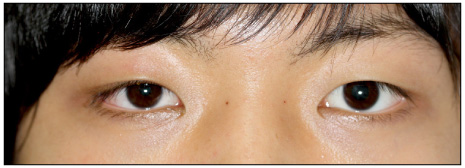J Korean Ophthalmol Soc.
2012 Jan;53(1):157-160. 10.3341/jkos.2012.53.1.157.
A Case of Iatrogenic Horner's Syndrome after Video-Thoracoscopic Surgery for Primary Pneumothorax
- Affiliations
-
- 1Department of Ophthalmology, Busan Paik Hospital, Inje University College of Medicine, Busan, Korea. eyeyang@inje.ac.kr
- 2Department of Thoracic and Cardiovascular Surgery, Busan Paik Hospital, Inje University College of Medicine, Busan, Korea.
- KMID: 2215259
- DOI: http://doi.org/10.3341/jkos.2012.53.1.157
Abstract
- PURPOSE
To report a case of iatrogenic Horner's syndrome after video-thoracoscopic surgery for primary pneumothorax.
CASE SUMMARY
An 18-year-old man with ptosis in the right eye was referred to our clinic. The patient had undergone wedge resection via video-thoracoscopic surgery for primary pneumothorax three weeks previously. On ocular examination, the palpebral fissure width was 7 mm in the right lid and 8 mm in the left lid, the marginal reflex distance 1 (MRD 1) was 2 mm in the right lid and 3 mm in the left lid, and the bilateral levator muscle function was good. Anisocoria was present, and pupil size in a dark room was 2.5 mm in the right eye and 4 mm in the left eye. The patient complained of facial anhidrosis on the right side of the face.
CONCLUSIONS
Although iatrogenic Horner's syndrome is rare complication of video-thoracoscopic surgery for primary pneumothorax, diagnosis after surgery of the thoracic cavity should be made carefully.
MeSH Terms
Figure
Reference
-
1. Walton KA, Buono LM. Horner syndrome. Curr Opin Ophthalmol. 2003. 14:357–363.2. Gallagher PG, Benzing G 3rd. Iatrogenic Horner's syndrome. J Crit Care. 1990. 5:238–240.3. Kaya SO, Liman ST, Bir LS, et al. Horner's syndrome as a complication in thoracic surgical practice. Eur J Cardiothorac Surg. 2003. 24:1025–1028.4. Sataline LR, Kraus T. Horner's syndrome occurring with spontaneous pneumothorax. N Engl J Med. 1965. 272:1227–1228.5. Aston SJ, Rosove M. Horner's syndrome occurring with spontaneous pneumothorax. N Engl J Med. 1972. 287:1098.6. Cook T, Kietzman L, Leibold R. "Pneumo-ptosis" in the emergency department. Am J Emerg Med. 1992. 10:431–434.7. Osterman PO, Osterman K. Reversible Horner's syndrome associated with spontaneous pneumothorax. Scand J Respir Dis. 1971. 52:230–231.8. Thakar C, Hunt I, Anikin V. Horner's syndrome in a patient presenting with a spontaneous pneumothorax. Emerg Med J. 2008. 25:119–120.9. Zagrodnik DF 2nd, Kline AL. Horner's syndrome: a delayed complication after thoracostomy tube removal. Curr Surg. 2002. 59:96–98.10. Jo YJ, Lee YH, Yun YJ, Lee SB. Iatrogenic Horner's syndrome after procedure in the neck and upper thoracic area. J Korean Ophthalmol Soc. 2009. 50:809–815.
- Full Text Links
- Actions
-
Cited
- CITED
-
- Close
- Share
- Similar articles
-
- Horner's Syndrome: A Rare Complication of Tube Thoracostomy: A case report
- Video-assisted Thoracioscopic Surgery under Epidural Anesthesia in the High-Risk Patients with Secondary Spontaneous Pneumothorax
- Thoracoscopic Bleb Ligation in Patients with Primary Spontaneous Pneumothorax
- Bullectomy Using 2 mm Videothoracoscope in Primary Spontaneous Pneumothorax
- Comparision of Clinical Results of Video-Assisted Thoracoscopic Surgery and Axillary Mini-Thoractomy for Spontaneous Pneumothorax




